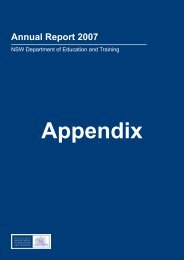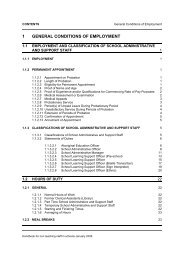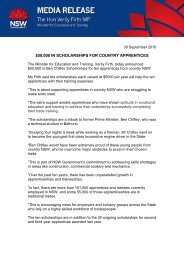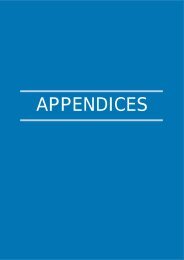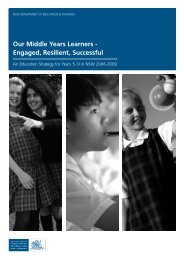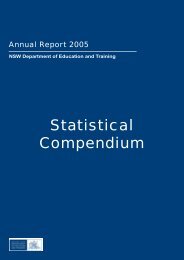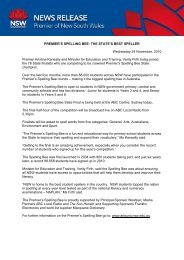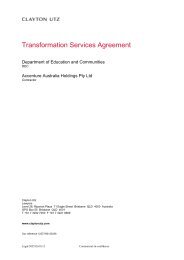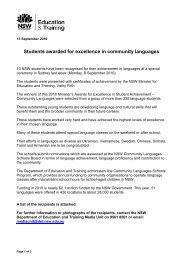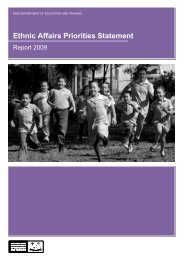Annual Report 2005 NSW Department of Education and Training
Annual Report 2005 NSW Department of Education and Training
Annual Report 2005 NSW Department of Education and Training
Create successful ePaper yourself
Turn your PDF publications into a flip-book with our unique Google optimized e-Paper software.
Appendices<br />
<strong>of</strong> approximately 2.5% was achieved over the 2004<br />
reporting period in comparison to the previous year.<br />
The Ryde Curriculum Directorate achieved outst<strong>and</strong>ing<br />
performance in the reduction <strong>of</strong> energy consumption<br />
through an awareness campaign, upgrading <strong>of</strong> air<br />
cooling systems <strong>and</strong> the installation <strong>of</strong> lighting <strong>and</strong> air<br />
cooling controls. The Facility received a 5 Star Australian<br />
Greenhouse rating by DEUS <strong>and</strong> was rated as one <strong>of</strong><br />
the five highest performing administration facilities in the<br />
<strong>NSW</strong> Government portfolio.<br />
Schools<br />
• Schools account for over 60% <strong>of</strong> the <strong>Department</strong>’s<br />
energy consumption<br />
• Average annual energy consumption per student was<br />
1670MJ<br />
• Average annual energy consumption per square<br />
metre floor area was 160 MJ<br />
• Total average consumption was slightly lower than the<br />
previous year.<br />
TAFE <strong>NSW</strong><br />
• TAFE <strong>NSW</strong> facilities account for almost 28% <strong>of</strong> the<br />
<strong>Department</strong>’s energy consumption<br />
• Average annual energy consumption per effective fulltime<br />
student was 4,032 MJ<br />
• Average annual energy consumption per square<br />
metre floor area was 365 MJ<br />
• Total average consumption was slightly lower than the<br />
previous year.<br />
The <strong>Department</strong> continues to meet the challenges <strong>of</strong><br />
achieving overall energy efficiency, while providing high<br />
quality learning environments which increasingly involve<br />
Table 17.1 Projects to improve efficiency<br />
high energy consumption from more computers in use,<br />
associated ICT equipment <strong>and</strong> air conditioning.<br />
Adopting best practice in the procurement<br />
<strong>of</strong> new assets<br />
Design <strong>and</strong> construction <strong>of</strong> new <strong>and</strong> refurbished<br />
education facilities continues to incorporate wellestablished<br />
ecologically sustainable design features in<br />
energy efficiency, water conservation <strong>and</strong> environmental<br />
considerations. Provision <strong>of</strong> low environmental impact<br />
facilities that ensure acceptable comfort condition<br />
levels are achieved through good design <strong>and</strong> passive<br />
ventilation. <strong>Education</strong> facility design features include:<br />
• Maximising the use <strong>of</strong> natural light in all new primary<br />
schools, <strong>and</strong> increasingly in high schools through the<br />
installation <strong>of</strong> ro<strong>of</strong> light strips<br />
• Integrating wind driven ro<strong>of</strong> ventilators to evacuate<br />
heat from ceiling spaces<br />
• Period bell light switching systems to automatically<br />
control lights in rooms in line with scheduled<br />
occupancy<br />
• Using insulation to reduce energy consumption for<br />
both heating <strong>and</strong> cooling<br />
• Using low flow water outlets <strong>and</strong> dual flush cisterns for<br />
improved water efficiency.<br />
Numerous research <strong>and</strong> installation projects were carried<br />
out in <strong>2005</strong> to enable the evaluation <strong>of</strong> energy efficient<br />
products. These ongoing trials ensure application <strong>of</strong> the<br />
latest technology in operations. Design specifications are<br />
applied, where appropriate, in planning <strong>and</strong> operation <strong>of</strong><br />
education facilities.<br />
During <strong>2005</strong> numerous trials <strong>of</strong> appliances were<br />
conducted <strong>and</strong> installation projects were completed.<br />
Some <strong>of</strong> those projects are detailed in the table below:<br />
Site Project Scope Result<br />
Northern Beaches<br />
Secondary Colleges<br />
-Manly <strong>and</strong> Cromer<br />
Campuses<br />
Upgrading<br />
existing light<br />
fittings<br />
Both schools had all electrical components<br />
removed from the rapid start light fittings <strong>and</strong><br />
were rewired with energy efficient components<br />
<strong>and</strong> triphosphur fluorescent tubes. The retr<strong>of</strong>it<br />
was carried out to all suitable light fittings in<br />
classrooms <strong>and</strong> administration areas.<br />
As an increase in light output was achieved, a 20%<br />
reduction in the number <strong>of</strong> fluorescent tubes was<br />
possible. The reduced electrical load will reduce<br />
annual energy consumption by an estimated<br />
148,000 kWh <strong>and</strong> provide a saving <strong>of</strong> approx.<br />
$14,000 per year.<br />
Various schools Phase 4<br />
- Solar in<br />
Schools<br />
In conjunction with the <strong>Department</strong> <strong>of</strong> Energy,<br />
Utilities <strong>and</strong> Sustainability, <strong>and</strong> Integral<br />
Energy, 1.5 kWh ro<strong>of</strong> mounted photovoltaic<br />
(solar) systems were installed in 27 schools<br />
throughout <strong>NSW</strong>.<br />
All electricity generated by the system is fed directly<br />
into the schools’ main electricity supply. This<br />
‘green energy’ reduces dem<strong>and</strong> for mains supplied<br />
electricity <strong>and</strong> therefore prevents the generation<br />
<strong>and</strong> release <strong>of</strong> approximately 49 tonnes <strong>of</strong> CO 2<br />
gas<br />
emissions into the atmosphere annually.<br />
Appendices<br />
Tuggerah Lakes<br />
Secondary College -<br />
Berkeley Vale Campus<br />
Upgrading<br />
existing light<br />
fittings<br />
All electrical components were removed from<br />
the rapid start light fittings in 32 classrooms.<br />
The fittings were upgraded with a prefabricated<br />
energy efficient kit, consisting <strong>of</strong> electronic<br />
ballast, wiring <strong>and</strong> triphosphur fluorescent<br />
tubes.<br />
While operation is presently being monitored, a<br />
reduced electrical load has been achieved as has<br />
a reduction in energy <strong>and</strong> maintenance cost. There<br />
has also been a substantial increase in light output<br />
while retaining the same number <strong>of</strong> fluorescent<br />
tubes.<br />
Hunter Institute <strong>of</strong><br />
TAFE<br />
Electricity<br />
consumption<br />
monitoring<br />
<strong>and</strong> reporting<br />
Monitoring <strong>and</strong> reporting <strong>of</strong> all major electricity<br />
accounts in the Hunter Institute <strong>of</strong> TAFE <strong>NSW</strong><br />
using real time data streams from remote read<br />
‘smart meters’.<br />
Provision <strong>of</strong> accurate electricity consumption<br />
data, at half hourly intervals, <strong>and</strong> analysis which<br />
is formatted to assist the facility operator to<br />
better manage electricity use to achieve reduced<br />
consumption <strong>and</strong> cost.<br />
Source: DET, Corporate Services<br />
107 <strong>NSW</strong> <strong>Department</strong> <strong>of</strong> <strong>Education</strong> <strong>and</strong> <strong>Training</strong> - <strong>Annual</strong> <strong>Report</strong> <strong>2005</strong>




